Page 92
Appendix C
Current Types of U.S. Landmines
This appendix provides descriptions of currently available antipersonnel landmines (APL) and some antitank (AT) mines that are part of mixed systems (see Table C-1). If current presidential policy continues, all of the pure APL described here, with the exception of the Claymore, will be unavailable to the U.S. military after 2003, except in Korea. If Congress ratifies the Ottawa Convention, all APL, including mixed systems will become permanently unavailable to the U.S. military everywhere. The loss of the Area-Denial Artillery Munition (ADAM), the only APL that can be delivered by artillery, would create a significant gap in U.S. military capabilities.1
Several disadvantages of current mines might be eliminated with alternatives. These include an inability to distinguish between combatants and noncombatants; the need for launch platforms for remotely delivered mines; and fratricide among friendly forces.
FOR USE AGAINST DISMOUNTED THREATS
Dismounted soldiers can be targeted using either hand-emplaced APL or the family of scatterable mines (FASCAM). Hand-emplaced APL, which are labor intensive and time consuming to use, can be exploded by direct pressure, a trip wire, or command. They may be either buried in patterned minefields or laid on the surface randomly or in a pattern. These mines were designed for use in protective and tactical minefields either by themselves or in conjunction with hand-emplaced AT mines.
Scatterable APL, which are remotely delivered, are designed for use in protective and tactical minefields. These mines are scattered on the surface in a random distribution and are programmed to self-destruct or self-deactivate after a certain period of time following deployment. Each mine has a preengraved fragmentation warhead and is detonated by pulling on a thin trip wire. Because scatterable APL can be delivered remotely, they can be used deep in the battlespace.
The limitations of the delivery system have a direct bearing on the size and ease of emplacement of a minefield. For instance, it takes considerable artillery assets to deliver a large pure AT minefield because each 155-millimeter (mm) projectile contains only nine mines. High-performance and rotary-wing aircraft can deliver a relatively large number of mines but may be vulnerable to enemy fire.
Figure C-1 shows how various landmine systems would be used across a battlefield. Each system has a particular mission on the battlefield.
Hand-Emplaced Mines
The M14 ( Figure C-2) is a nonself-destructing blast mine with a cylindrical plastic body (56 mm in diameter and 40 mm high) and a minimum metal content of approximately 2.36 grams in the firing pin. The M14 is fired when pressure (11.5 to 13.5 kilograms [kg]) is applied to the top surface. The main charge is 28.35 grams of tetryl. The design was chosen because of logistical considerations; because of their small size, a soldier can carry several M14 mines. U.S. forces use the M14 only in Korea, where metal washers have been added to meet detectability requirements of the Convention on Conventional Weapons (CCW).
The M16 ( Figure C-3) is a nonself-destructing, cylindrical, metal-body mine (103 mm in diameter and 199 mm high, including the fuze) with a bounding fragmentation warhead. It weighs 3.5 kg and contains 450 grams of TNT. The M16 has a casualty radius of 27 to 30 meters, and the mine is detonated by a direct force of 3.6 to 9 kg or a pull of 1.4 to 4.5 kg on a trip wire.
Figure C-4 shows a pursuit denial munition, a self-destructing/self-deactivating APL. It is an adaptation of a single ADAM mine. The pursuit denial munition is a
1 To fill this anticipated gap, the U.S. Department of Defense has proposed using the Remote Area-Denial Munition (RADAM) described in Chapter 6.
Page 93
|
Dismounted Enemy |
Mounted Enemy |
|||||||
|
System Name |
APL/AT/Mixed Non-mine |
Self-destructing/Self-deactivating |
Lethal/Nonlethal |
Ottawa Compliant a |
Remotely Delivered |
Hand Emplaced |
Remotely Delivered |
Hand Emplaced |
|
M14 |
APL |
N |
L |
N |
X |
|||
|
M16 |
APL |
N |
L |
N |
X |
|||
|
Claymore(M18) |
APL |
N |
L |
Y |
X |
|||
|
Pursuit-Denial Munition (PDM) |
APL |
Y |
L |
N |
X |
|||
|
Ground-Emplaced Mine Scattering System (GEMSS) |
Mix |
Y |
L |
N |
X |
X |
||
|
Modular-Pack Mine System (MOPMS) |
Mix |
Y |
L |
N |
X |
X |
||
|
Area-Denial Artillery Munition (ADAM) |
APL |
Y |
L |
N |
X |
|||
|
Remote Antiarmor Mine System (RAAMS) |
AT |
Y |
L |
Y |
X |
|||
|
Gator |
Mix |
Y |
L |
N |
X |
X |
||
|
Hornet / Wide Area Munition (WAM) |
AT |
Y |
L |
Y |
X |
|||
|
Volcano (M87) |
Mix |
Y |
L |
N |
X |
X |
||
|
Volcano (M87A1) |
AT |
Y |
L |
Y |
X |
Note: Systems in italics will not be available outside Korea after 2003 and will not be available anywhere once the Ottawa Convention is ratified.
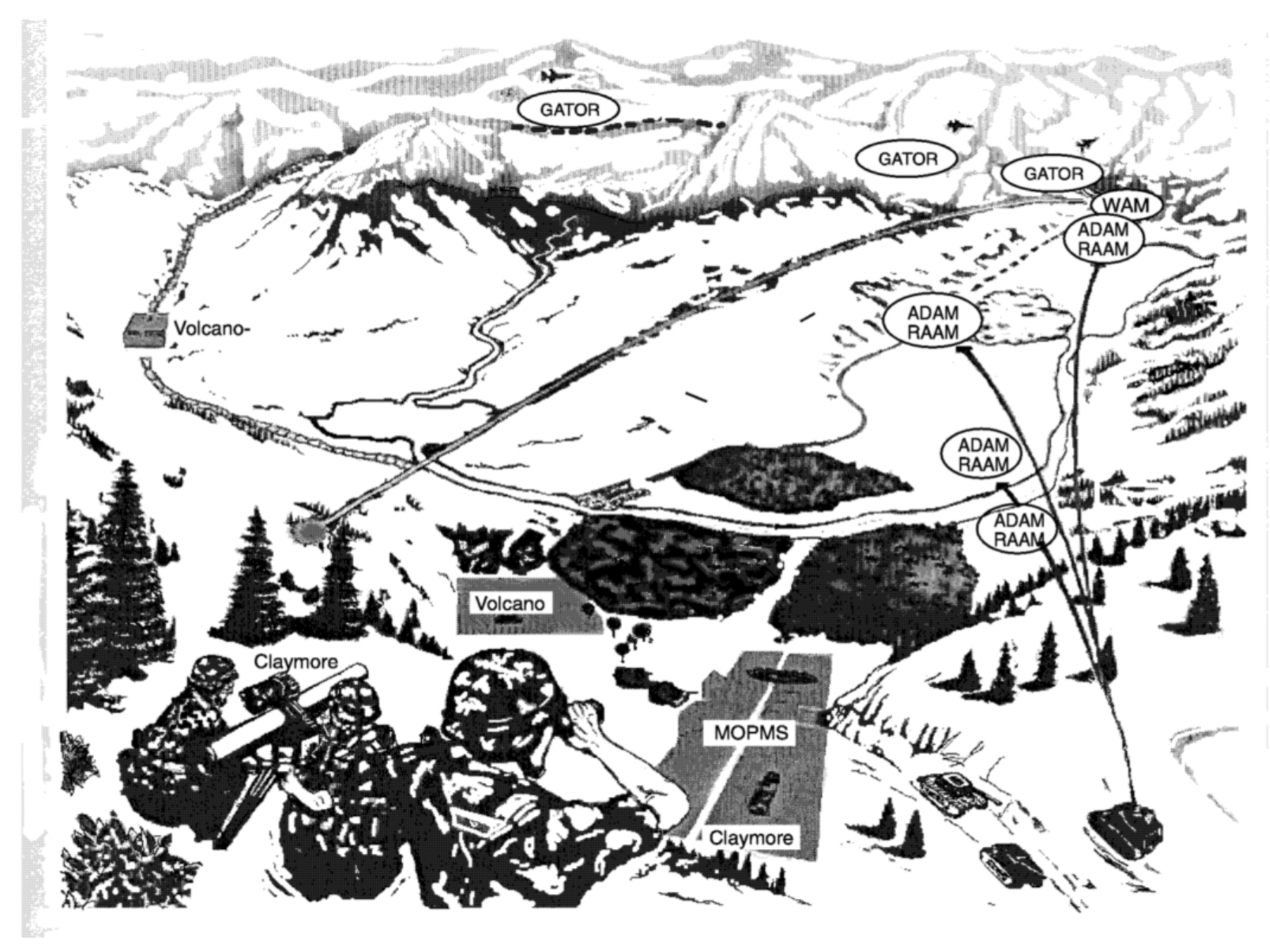
~ enlarge ~
FIGURE C-1 Landmine systems on the battlefield.
Page 94
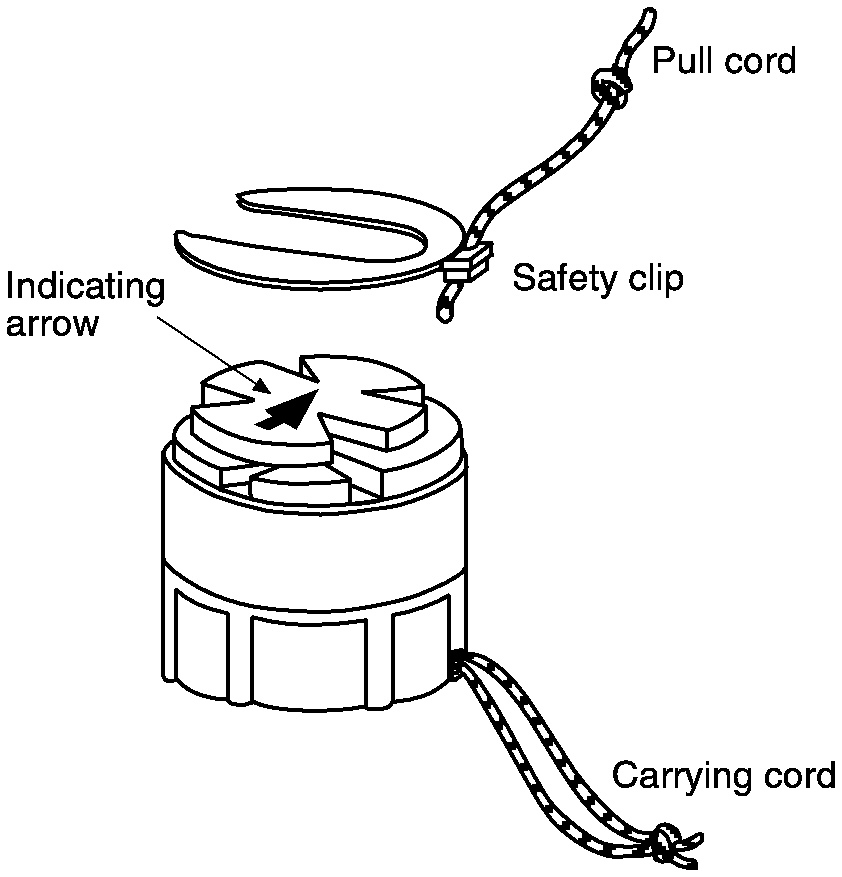
~ enlarge ~
FIGURE C-2 M14.
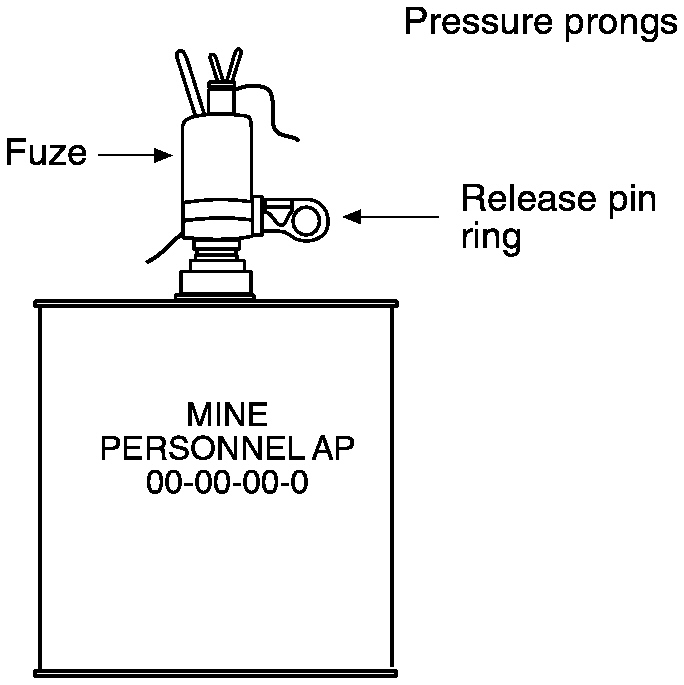
~ enlarge ~
FIGURE C-3 M16.
hand-placed mine used by Special Operating Forces to inhibit enemy pursuit during a withdrawal from an operational area. Conceptually, this munition can be carried and used similarly to a hand grenade, but it has the capabilities of an APL. It has a factory-set self-destruct time of four hours. After placement, it operates exactly like an ADAM mine.
The M18 series, or Claymore mine ( Figure C-5), is a nonself-destructing directional fragmentation mine detonated by 682 grams of composition C4. The Claymore projects 700 steel balls in a fan-shaped pattern in a 60-degree arc to a maximum height of 2 meters. The M18 can be activated in the command-detonation mode by an electric blasting cap inserted into the detonator well. The mine body is nonmetallic, and the steel balls are cast in the composition that comprises the front part of the mine. The lethal radius extends to 100 meters forward and 16 meters to the rear. The Claymore mine is issued with an electric initiation system (hand generator, wire, and electric blasting cap) and is now doctrinally detonated by command, although so-called “mechanical ambushes,” using trip-wires, were common during the Vietnam War. Amended Protocol II to the CCW imposes restrictions on the use of trip wires to detonate Claymores; the
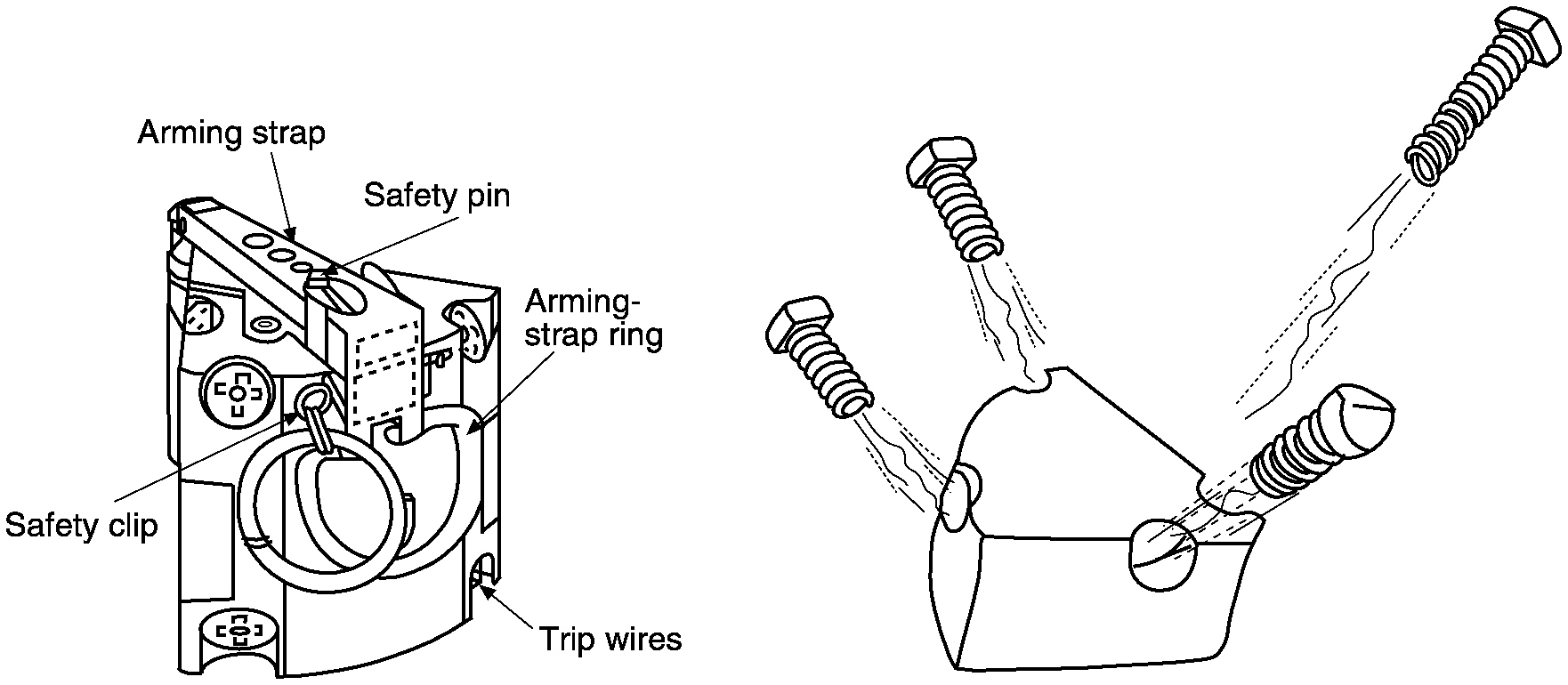
~ enlarge ~
FIGURE C-4 Pursuit denial munition.
Page 95
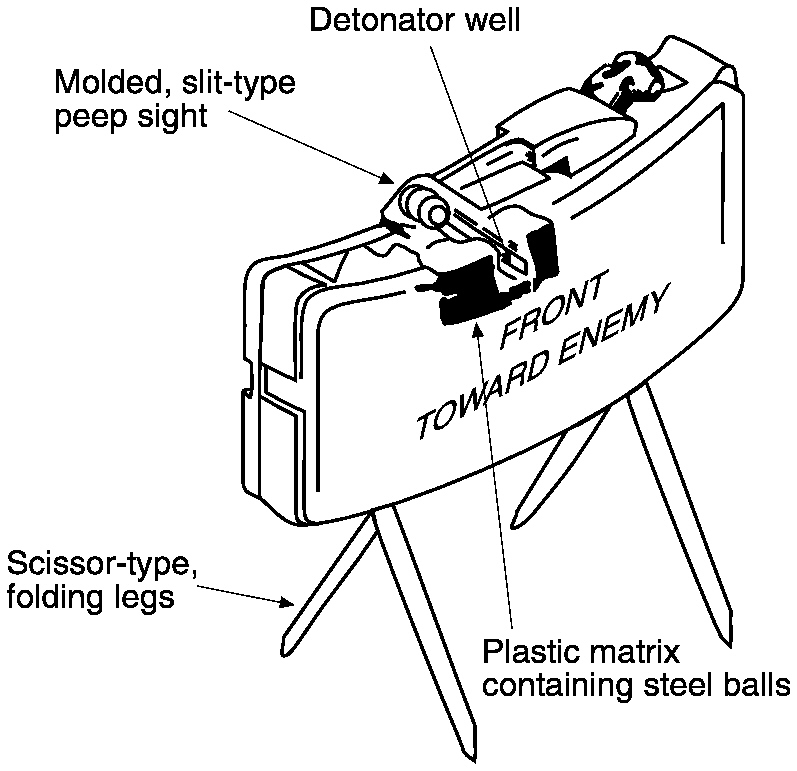
~ enlarge ~
FIGURE C-5 M18 Claymore.
Ottawa Convention prohibits the use of trip wires with all mines. The command-detonated Claymore does not use a trip wire and is, therefore, permitted by both the CCW and the Ottawa Convention.
Remotely Delivered (Scatterable) Mines
The ADAM system ( Figure C-6), a self-destructing/self-deactivating APL, consists of a 155-mm howitzer projectile that contains 36 APL. When the projectile time fuze fires at the scheduled time, the mines are ejected from the base of the projectile above the target area. Each mine is a 60-degree wedge with a radius of about 63 mm and a height of about 70 mm; a full cylinder inside the projectile holds six mines. Once the mines land on the ground, depending on their orientation, three or four 6-meter-long trip wires are deployed for each mine. The trip wires are thin, olive drab filaments that are difficult to see. Each mine has a spherical prefragmented kill mechanism with a charge of 21 grams of composition A5 explosive. When a force of .9 kg to 1.4 kg is exerted on the trip wire, the spherical warhead is projected upwards and explodes 0.6 to 2.4 meters above the ground; the lethal radius is 6 to 10 meters. ADAM mines have factory-set self-destruct times of either 4 or 48 hours; all of the mines in a projectile have the same self-destruct time.
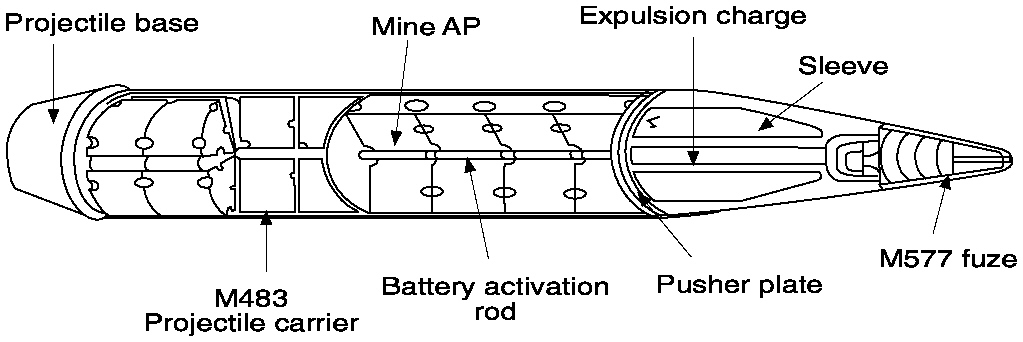
~ enlarge ~
FIGURE C-6 ADAM mine projectile.
ADAM mines are used in conjunction with AT mines to delay dismounted breaches. In counterbattery fire, they are most effective against towed artillery. Because they are artillery-dispensed submunitions, it is difficult to use them in protective minefields close to friendly troops. The maximum range of the projectile is approximately 20 kilometers, and a significant number of artillery assets are required to create or cover a large minefield.
FOR USE AGAINST MOUNTED THREATS
The mines intended to destroy tanks or tracked vehicles are large, sometimes relatively easy to see munitions that can be countered in a variety of ways. Sometimes APL are used with AT mines to discourage an enemy from neutralizing the larger mines and breaching the minefield. Opinions differ about the efficacy of using APL to protect AT mines. With the exception of the Hornet/Wide Area Munition (WAM), which must be hand emplaced, all of these mines are remotely delivered. All AT mines are powered by reserve cells, have an electronic fuze or lens, contain a safeand-arming device to provide environmental sensing, and are exploded by an electric detonator. AT mines are scattered on the surface and set to self-destruct at a designated time. They use magnetic-influence fuzes and the MiznayShardin effect (or self-forging fragment) to provide fullwidth coverage under armored targets. Because each artillery projectile contains only nine mines, a considerable amount of artillery is required to deliver a large AT minefield. High-performance or rotary-wing aircraft can deliver a relatively large number of mines but may be vulnerable to enemy fire.
Mixed systems combine APL and AT mines in a single delivery mode, carried by soldiers, ground vehicles, or aircraft. All of the mines have the same physical properties (right-circular cylinders, approximately 120 mm in diameter, 80 mm high, and weighing approximately 1.8 kg). The type of safe-and-arming device and is determined by the launch environment.
Hand-Emplaced Mines
The Hornet/WAM ( Figure C-7) is an autonomous AT mine currently entering inventory in the hand-emplaced version. It weighs about 16 kg, is about 36 cm high and about 23 cm in diameter. After it is emplaced and armed, its seismic sensors can detect movement, and alert the mine to turn on its acoustic sensors to detect and classify a target. If an armored target approaches within 100 meters, a small
Page 96
submunition or sublet with an infrared sensor is launched over the target and fires an explosively formed projectile down into the engine compartment. The Hornet/WAMs has an antihandling feature that causes the mine to detonate when disturbed. The Hornet/WAMS is designed to operate for 30 days after emplacement and to then self-destruct. The sublet is similar to the sublets in the Air Force Sensor-Fuzed Weapon. Original plans called for the Hornet/WAM to be dispensed from a Volcano launcher or a deep-attack asset, such as the Multiple-Launch Rocket System (MLRS) or the Tactical Missile System (TACMS), in addition to hand emplacement. However, subsequent evolutions of requirements and the exigencies of the development program have precluded these options. Therefore, for the foreseeable future, Hornet/WAM will be hand emplaced, which sharply limits its utility.
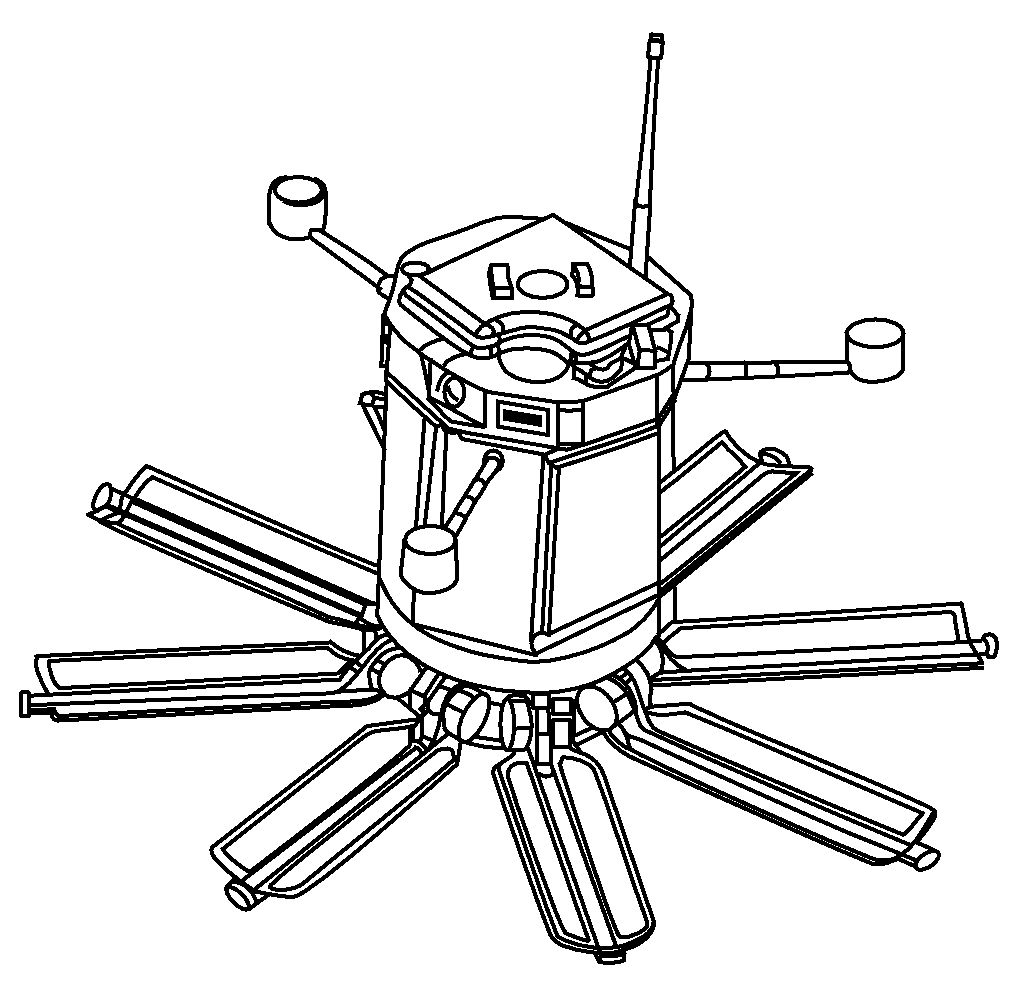
~ enlarge ~
FIGURE C-7 Hornet/WAM.
Remotely Delivered (Scatterable) Mines
The Remote Antiarmor Mine System (RAAMS) ( Figure C-8) consists of a 155-mm howitzer projectile containing nine AT mines. RAAMS is usually used with the ADAM, but can be used alone. Each mine in the projectile is a rightcircular cylinder, 11.25 cm in diameter and 7.5 cm high, weighing 1.8 kg and containing about 0.78 kg of pressed explosive in the main charge. RAAMS have factory-set self-destruct times of either 4 or 48 hours. About 20 percent have an antihandling feature that causes them to explode when tilted at an angle of 17 degrees or more. RAAMS are designed to destroy mounted targets by perforating the underside of the vehicle. The mines have magnetic-influence fuzes designed to stop mounted vehicles when they are detonated, as intended, between the tracks; if they are detonated directly under a track, they may not stop the vehicle.
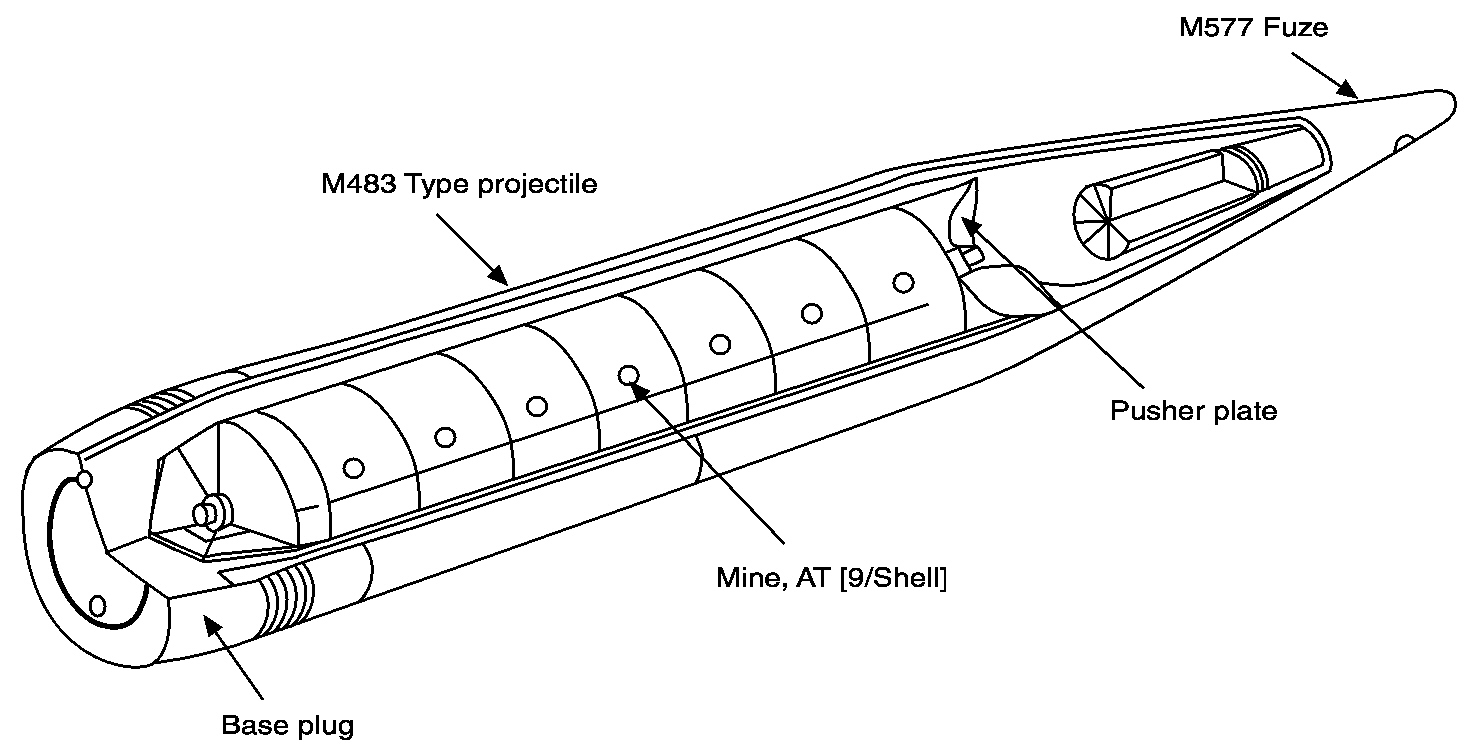
~ enlarge ~
FIGURE C-8 RAAMS projectile.
The Ground-Emplaced Mine-Scattering System (GEMSS/Flipper) was the first scatterable mine system fielded by the Army (RAAMS/ADAM was the second). Although GEMSS ( Figure C-9) is now obsolete, the mines are still in the U.S. inventory. The GEMSS dispenser is a large trailer that can be towed by a variety of wheeled and tracked vehicles. A relatively large tactical minefield can be laid in areas controlled by friendly forces. The dispenser holds 800 mines and can lay mines in 26, 34, or 60-meter wide strips in five different densities. The mines come in sleeves of five mines each. The operator sets self-destruct times at either 5 or 15 days. Because the system is unwieldy to tow and operators were vulnerable to small arms fire, the utility of the system was limited. Flipper is a relatively small,
Page 97
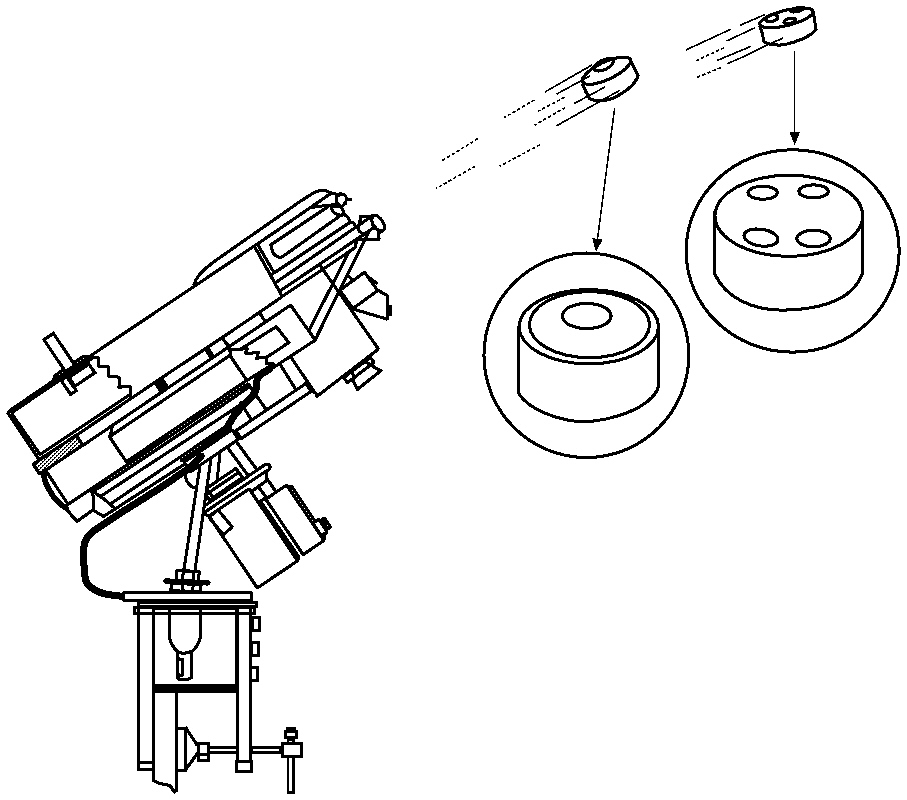
~ enlarge ~
FIGURE C-9 GEMSS system.
manual, auxiliary dispenser system designed to dispense GEMSS mines. Flipper can be mounted on the rear of a vehicle and was used mostly to place small point or protective minefields close to friendly troops.
The Modular-Pack Mine System (MOPMS) ( Figure C-10) is normally used to fill in gaps in larger minefields and to establish point minefields. More systems are required to construct a large tactical minefield than are normally available to a single unit. Each man-portable dispenser contains 17 AT mines and 4 APL. The mines are dispensed on command by a signal sent either by wire or from a special radio transmitter. If the mines are not dispensed, the dispenser can be relocated and used elsewhere. The mines have a set self-destruct time of 4 hours. Of all currently available scatterable mines, MOPMS is the only system capable of extending the self-destruct time (up to three times). In addition, MOPMS can be detonated by command if the tactical situation dictates.
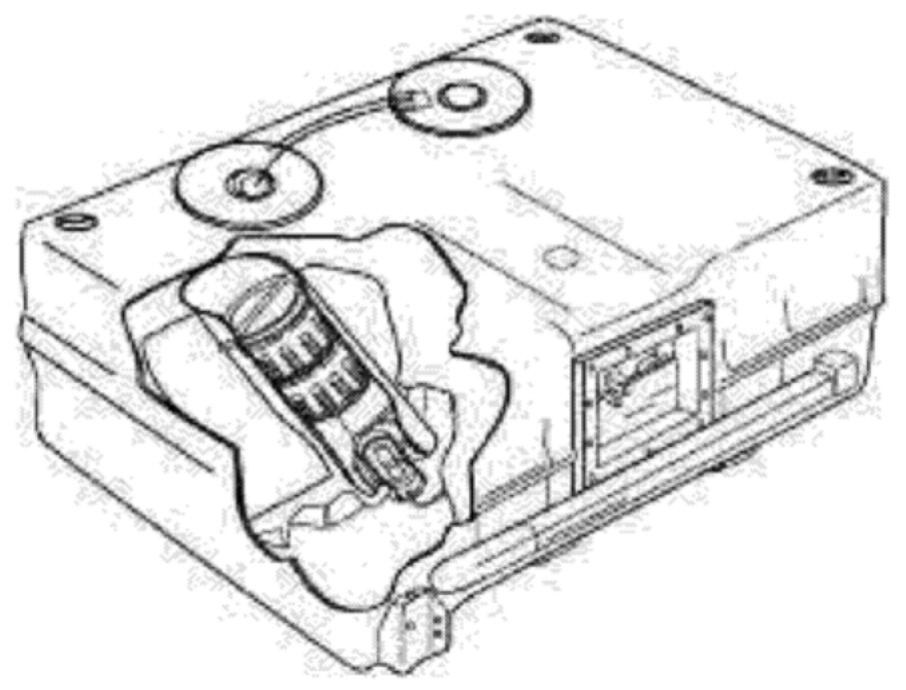
~ enlarge ~
FIGURE C-10 MOPMS.
Gator mines ( Figure C-11) are delivered by highperformance aircraft and can be used anywhere on the battlefield a tactical aircraft can reach. The Air Force and Navy versions of Gator differ only in the number of mines contained in the tactical munitions dispensers used to deliver them. The Air Force dispenser, the CBU-89/B, contains 72 AT mines and 22 APL; the Navy dispenser, the CBU-78/B, contains 45 AT mines and 15 APL. All of the mines have square-shaped, aeroballistic protective casings designed to aid dispersion after the dispenser opens above the target area. Prior to release, the pilot sets self-destruct times of 4 hours, 48 hours, or 15 days. Although Gator can be used in close combat situations, it is normally used against deep or interdiction targets.
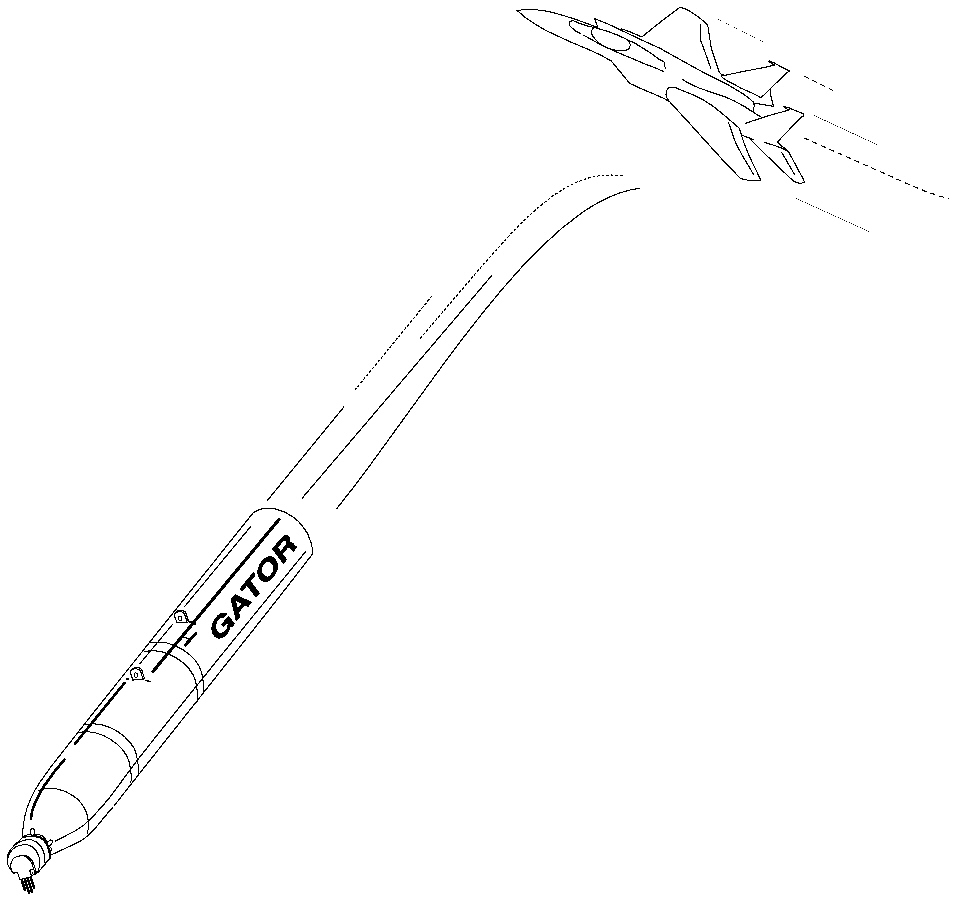
~ enlarge ~
FIGURE C-11 Gator projectile.
Page 98
The Volcano system (M87) ( Figure C-12) replaced the older M56 helicopter-delivered AT mine system and the GEMSS/Flipper system. The M87 is a mixed system and the M87A1 is a pure AT system. Volcano dispensers can be mounted on several tracked or wheeled vehicles or on the UH-60 Blackhawk helicopter. The system is made up of the launcher rack and dispenser-control unit, vehicle-specific mounting hardware, and mine canisters, each of which holds six mines. A completely loaded dispenser holds 160 canisters, or 960 mines. The mines are placed in a uniform density of approximately one mine per linear meter over a linear distance of one kilometer. Self-destruct times of 4 hours, 48 hours, or 15 days are set at launch time. The Volcano system can be used to emplace protective and tactical minefields anywhere on the battlefield reachable by the dispensing vehicles.
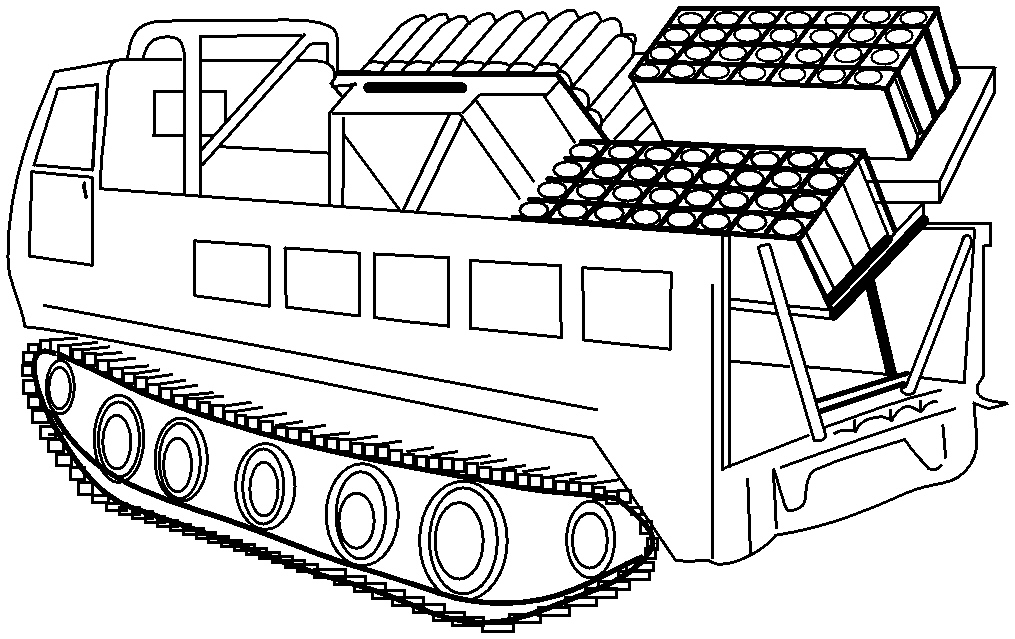
~ enlarge ~
FIGURE C-12 Volcano delivery system.







